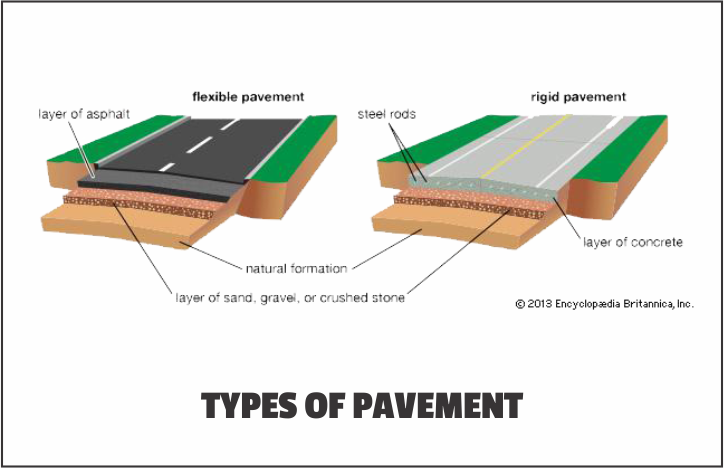Based on their structural performance, pavements can be divided into two categories: flexible pavements and stiff pavements. Wheel loads are conveyed by the aggregates in flexible pavements coming into touch with one another as they pass through the granular structure. Due of its lower flexural strength, the flexible pavement behaves like a flexible sheet (e.g. bituminous road).The flexural strength of rigid pavements, on the other hand, transfers wheel loads to the sub-grade soil.

Flexible Pavements
- By transferring wheel load strains from the upper layers to the lower layers through grain-to-grain contact at the granular structure’s sites of contact, flexible pavements can do this.
- A greater area will be affected by the wheel load acting on the pavement, and the stress will decrease as depth increases.
- Flexible pavement typically includes numerous grooves to take use of this stress distribution trait layers.
- As a result, the idea of a layered structure is used in the design of flexible pavement.
- Using this as a foundation, it is possible to build flexible pavement in several layers, however the top layer must be highest quality to withstand the greatest compressive loads as well as wear and tear.
- Less high-quality material can be utilised because the lower layers will be under less stress.
- Bituminous materials are used to build flexible pavements.
- These can take the shape of asphalt concrete surface courses, which are typically used on high-traffic roads like national highways, or surface treatments like bituminous surface treatments, which are typically found on low-volume roads.
- Flexible pavement layers reflect surface layer deformation from the bottom layers.
- When designing flexible pavement, the total performance is taken into consideration, and the stresses generated should be kept considerably below the allowed stresses of each pavement layer.
Rigid Pavements
- The flexural strength of rigid pavements is sufficient to distribute the stresses caused by wheel loads to a larger area below. Figure below depicts a typical cross section of stiff pavement.
- Since there is just one layer of material between the concrete and the sub-grade, this layer can be called the base or sub-base course.
- In contrast to flexible pavement, rigid pavements are installed either directly on the prepared subgrade or on a single layer of granular or stabilised material.
- Rigid pavement functions as an elastic plate resting on a viscous medium, distributing load by the slab action.
- Since rigid pavements are made of Portland cement concrete (PCC), plate theory should be used to examine them rather than layer theory.
- In a condensed version of layer theory known as plate theory, a concrete slab is viewed as a medium-thick plate that is plane both before and after being loaded.
- Wheel load, temperature changes, and the consequent tensile and flexural stress are what cause the slab to bend.
- Unlike with flexible pavement, the pressures are not transferred from grain to grain.
